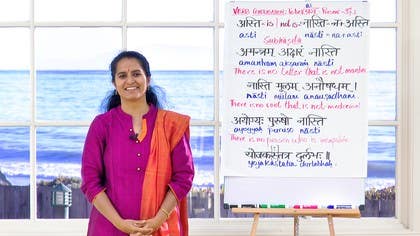Description
About This Video
Transcript
Read Full Transcript
Namo namaha. This is another way you can greet a friend when you meet them, especially if they speak Sanskrit, you can do that. So namona maha. What we will look at today is the conjugation of the verb to be. It's one of the most important verbs of existence, to be, the root form of to be is us, us.
I have written it in the transliteration. You just need to pay a little attention that you are not doing it, you are not pronouncing it as an as, it's an us and we look at it in the present tense as well as in the singular. So I have a new object for you today, kandukam, kandukam is like a little ball, okay, kandukam. See that, kandukam, kandukam asthi, the ball is in my hand, kandukam asthi. kandukam nasti, it is not there, kandukam nasti.
So asthi means is there and nasti is not there. So you see it is nasti, asthi here once is asthi is, not is, is nasti. The form nasti is a combination of na plus asthi, na means not, asthi is. So not is, it is not there, nasti. So is is, asthi is not, nasti again, asthi, nasti.
On set we have the flowers today, push pam asthi. So we will just talk of one flower now. So push pam asthi, fruit, no fruit today, palam nasti, palam nasti. Is Alana or Clark on the scene today, no. So Alana nasti, here Alana nasti, got that.
So you can talk of objects or you can talk of people and when they are you would say asthi and when they are not there it would be nasti, great. A small thing about the verb to be, I was once trying to study some German and trying to see or rather trying to compare the words in different languages. So German and Sanskrit because they say there is a lot of similarity between these two languages. So when I was studying the auxiliary verbs in German, you have like in most Romano languages, we have to be and to have. I had the verb for to be which is us but then I was trying to think of to have and I didn't find any verb to have and then to my utter amazement I discovered that in Sanskrit there is no verb to have, everything is.
In terms of psychology it's quite interesting because when we talk of to have something then we sort of remove the existential value of that thing by itself because it's so completely mine. But when we say that that is, so for example if I say I have the ball, I am important, alright whereas if I say the ball is with me, it is in my possession but the ball is, its existential value is totally respected. So I just thought it fabulous that you know a language as ancient as Sanskrit which has such extensive literature in every single field of life, it's a mind blowing amount of literature out there and there was no need to conceive of the verb to have, I mean how fantastic is that? It represents a certain worldview, something to think about I think, alright so coming back to is and is not, pushpam or flower is pushpam asti, colour pen varanalekani asti, what is not there? A fruit, palam nasti, palam nasti, do we have a glass around, no, charsha kaha nasti, got that?
Familiar with that now, asti nasti, I'd like to share with you a nice verse, in Sanskrit we call them the subha-shitas, I'll write it out for you, subha-shita, subha-shita, I'll just do it in the transliteration for you, just yeah, so the word subha-shita is formed of su and bha-shita, su in Sanskrit is a prefix that means good or beautiful, excellent, all of that and bha-shita comes from the root bha which means to say, to say something, to shine, it actually means to shine, so subha-shita in this context means that which is well said, so there are many verses in Sanskrit, short verses that are packed with wisdom, so I'll tell you one of them here which uses a lot of asti and nasti which I thought would be fun to learn together. So we have this verse that says, a-mantram aksaram nasti, you are familiar with the word mantra, now when you add the a before the word mantra it makes it the negative, so it becomes not a mantra, or the absence of a mantra, very specifically in this case not a mantra, aksaram, aksaram means a letter, the letter in the Sanskrit alphabet, so it's saying nasti is not, this is a bit of a double negative, so you work your head a little bit, so I'll help you understand this first part of the verse. So what is not, the letter is not, so aksaram nasti, what do you mean by letter is not, it specifies, a-mantram, so it says that there is no letter which is not a mantra, that's a double negative, which would imply that all letters are mantras, are powerful sounds, call that, so there is no letter which is not a mantra, I'll just write that out here, a-mantram aksaram nasti which means that all letters are powerful sounds, nasti you know is not, moolam is a root, aushadham means medicinal, anaushadham means not medicinal, so again we have the double negative, so it says that there is no root that is not medicinal, which means that every single root is medicinal, so I'll just write that there is no root that is not medicinal, so nasti no root not medicinal, there is no root that is not medicinal, we continue, a-yogya means somebody who is capable, a-yogya incapable, purusho or person, nasti, there is no person who is incapable, so got that, there is no person who is incapable, this is actually a riddle which means in this case that every individual is basically capable of doing things, so it says, now just see the kind of picture, the world that it is presenting to us, it says that every single letter is powerful, every single root is medicinal, every human being is capable, but if that was the situation then why so much of disease, how come there is so much of incompetency around, and then answer is in the last one, it says yoja kaha tatra durlabha, here it's yoja kas, but this kas is actually a phonetic change of the kaha, so yoja kas tatra durlabha, he is difficult to find, so I hope you got that, if every sound is powerful then why are there so many difficulties in the world, that is because the one who can connect the sound to its power is hard to find, the second line if every root is medicinal then why is there so much of disease, and that is because the one who can connect the right root to the required medicine is rare, the third line every individual is capable, if we look around sometimes it doesn't seem so, why is that? Because the one who can match the potential of every individual to what they are capable of realizing, that link person is missing, so this is a good one I find to help us learn the asti-nasti, and give us also a little insight into life, and the importance to find people who can link knowledge to their application, if we can't find the people out there, to try and become oneself as much as a connector as one can, to make the world a better place, so I'll say that and you repeat after me, amantram aksaram nasti, nasti moolam anausradham, ayogya purusho nasti, yojakas, yojakas, tatra, durlabha, such a person is rare, I'll just write that last meaning there, yojakaha is the link person, tatra is there, you will notice that in this last line although I have written the verb is, there is no verb here which is asti, in fact if you look at the whole verse we don't really find asti anywhere, we have nasti, we have nasti, we have nasti but there is no asti, so how did I just put this asti in there, now in Sanskrit many a times we don't really spell everything out, so although the verb is, is not in there but it is understood, it's as if understood, similarly when we are talking of is and is not like asti or nasti, it is not essential for us to say saha asti, saa asti or you know the pronoun is not required, the very fact of saying asti, the ending t is indicative of who is performing that particular action or who is, so there we go, I think that's a very simple but quite a powerful verse that we can try and remember together, right? Durlabha, call that, a small detail there, you have a yogya, puru shaha, puru sho, that a yogya when it is followed by the sound per becomes a yogya, puru sho but that really is a detail, I thought I will just point that out to you, so what I will do next is I will sing it out for you and as I sing it, I request you to join along after me, so just repeat after every line, there we go, amantram aksharam nasti, amantram aksharam nasti, nasti mula a yogya puru sho nasti, a yogya puru sho nasti, yojakastatra durlabha, yojakastatra durlabha, fantastic, want to join me one last time, we say it together, amantram aksharam nasti, nasti mula ma naushadham, a yogya puru sho nasti, yojakastatra durlabha, great, a teeny mini mini last point to put into your, to drop into your consciousness before I leave you, when you have sounds amantram aksharam, you will see that there is a natural tendency to roll the sound into the other, so if you say amantram aksharam, that's when they are separated, put it together, amantram aksharam, it becomes a m, so m plus an a would become a full m, amantram aksharam nasti, nasti mula, again we have the same combination, so m plus a becomes a m and then this is not pronounced and that is not pronounced, similarly this is not pronounced and that is not pronounced, yeah, one last time we do it together, amantram aksharam nasti, nasti mula ma naushadham, a yogya puru sho nasti, yojakastatra durlabha, fantastic, practice that, this is a good one for aasthi nasti, aasthi nasti, enjoy, namaste.
Mother Tongue: Verbs
Comments
You need to be a subscriber to post a comment.
Please Log In or Create an Account to start your free trial.










